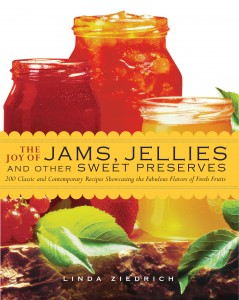 |
Every wednesday I review a cookbook to help weed out the good the bad and the ugly. This week I am reviewing, The Joy of Jams, Jellies and Other Sweet Preserves. I reviewed the Joy of Pickling a couple of weeks ago, and I must say that Linda Ziedrich is the Queen of preserving food. Her lastest book allows you to showcase the fabulous flavors of the fruit without masking them in artificial sweetners, chemicals and artificial flavorings. As a matter of fact, not a single one of the recipes in the book require store bought pectin. So this is the ultimate way to make fresh, healthy and tasty jams, jellies and preserves. |
The hardest part about making homemade jams, jellies and preserves is mastering the technique. Anyone can read a recipe, but turning that recipe into a spectacular preserve takes technique. The first part of this book contains the Preserver’s Primer. A section explaining the techniques and vocabulary that will be used in the recipes. For instance, what is the difference between grape jam, grape jelly and grape preserves. Jam is crushed or chopped fruit that is cooked with sugar until the mixture sets. Jelly is a gelled mixtured of sugar and juice that is acidic. Preserves are whole or sliced fruits in syrup or jelly.
Linda goes on to describe the advent of packaged pectin and why it became so popular. Story short, it made cooks lives easier, but it also took away from the art of preserves. She includes a chart of natural pectin content in each type of fruit. For example, Strawberries are low in pectin and actually may need some artificial pectin to make them solid. Also natural pectin reacts with sugar and heat. So, Linda describes the sugar content needed for each pectin level of fruit. All of this stuff is great information that you can not get from the directions in a gelatin box.
Another important part of the Preserver’s Primer is how to test for gelling. Gelling is the point wherein your preserve is done and ready to be jarred. It can be done by temperature, a spoon test or by a saucer test. Each test has its own negatives and postives, but Linda has explained all of them so if you are cooking you can try each. That way you can perfectly cook the preserves every time. Linda has also included a troubleshooting guide on pages 30-31 to help you determine what went wrong with your preserves if you have a problem, and the preventative measures that should be taken to avoid the problem in the future.
The rest of the book is organized in by fruit in alphabetical order. She includes over 200 recipes from everything from Apples to Zucchini Preserves. The recipes are all straight forward and include a list of ingredients and exact directions in big print.
The best part of this book is the background into jam and jelly making, along with descriptions of the techniques necessary to make perfect jams and jellies. Linda Ziedrich has written a book that describes the processes involved in making jams and jellies in a way, that any novice could pick it up in an afternoon. If you are sick of the flavorless mass produced jams and jellies in the supermarket, I recommend that you pick up this book. After reading this book, I wanted to go to the Farmer’s Market and buy all of the fresh fruits in season, so that I could start making jams and jellies.
The book is available at Amazon for less that $15. The Joy of Jams, Jellies, and Other Sweet Preserves: 200 Classic and Contemporary Recipes Showcasing the Fabulous Flavors of Fresh Fruits

